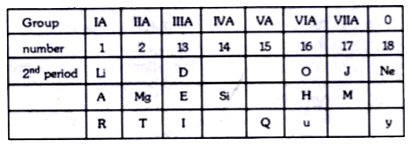The most electronegative element is
Sodium
Aluminium
Bromine
Fluorine
The correct Answer is:D
Across the period, electronegativity increases and down the group, electronegativity decreases.
Topper's Solved these Questions
Similar Questions
Knowledge Check
Which of the following configurations represents the most electronegative element?
A1s22s22p63s1B1s22s22p5C1s22s22p63s23p5D1s22s22p4
Choose the correct answer from the options A,B,C&D given: The most electronegative element from the following elements is:
View SolutionThe oxidation states of the most electronegative elements in the products of the reaction between BaO2 and H2SO4 are
View SolutionThe oxidation states of the most electronegative elements in the products of the reaction between BaO2 and H2SO4 are
View SolutionOxidation number is the charge which an atom of an element has in its ion or appears to have when present in the combined state. It is also called oxidation state. Oxidation number of any atom in the elementary state is zero. Oxidation number of a monoatomic ion is equal to the charge on it. In compounds of metals with non metals, metals have positive oxidation number while non metals have negative oxidation numbers. In compounds of two difference elements, the more electronegative element has negative oxidation number whereas the other has positive oxidation number. In complex ions, the sum of the oxidation number of all the atoms is equal to the charge on the ion. If a compound contains two or more atoms of the same element, they may have same or different oxidation states according as their chemical bonding is same or different.
The oxidation state of the most electronegative element in the products of the reaction between BaO2 and H2SO4 are
View Solution
• In this table H does not represent hydrogen.
• Some elements are given in their own symbol and position in the periodic table.
• While others are shown with a letter.
With reference to the table answer the following questions :
Identify the most electronegative element.
View SolutionTransition metals combine with halogens at high temperature to form compounds called halides. On account of high activation energy , the reactions require high temperature to start, but once the the reaction is started , the heat of reaction is sufficient to maintain the continuity .
Metals in higher oxidation state form flourides as it is the most electronegative element . Flourides are ionic in nature . The chlorides , bromides and iodides have ionic as well as covalent character . Halides of metals is higher oxidation states are relatively unstable and hydrolysed very easily .
ΔHf is negative for
View SolutionTransition metals combine with halogens at high temperature to form compounds called halides. On account of high activation energy , the reactions require high temperature to start, but once the the reaction is started , the heat of reaction is sufficient to maintain the continuity .
Metals in higher oxidation state form flourides as it is the most electronegative element . Flourides are ionic in nature . The chlorides , bromides and iodides have ionic as well as covalent character . Halides of metals is higher oxidation states are relatively unstable and hydrolysed very easily .
Aqueous solution of which compound will have pH<7 ?
View Solution
